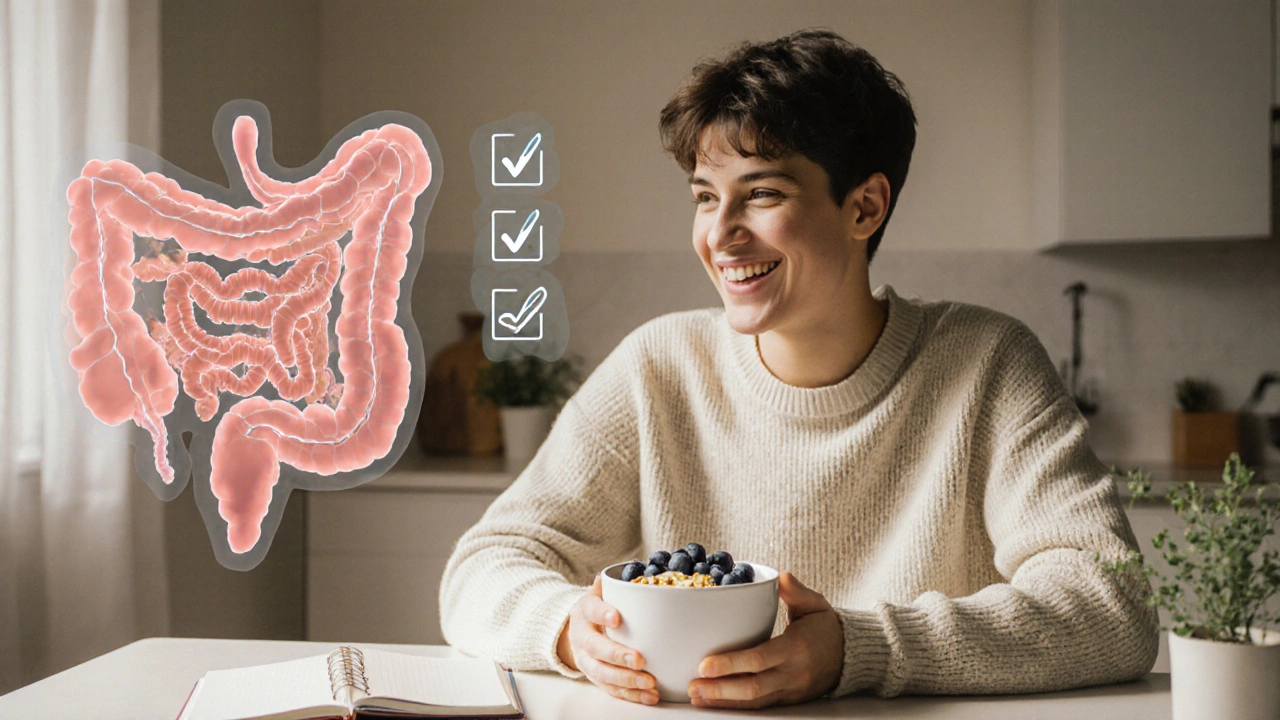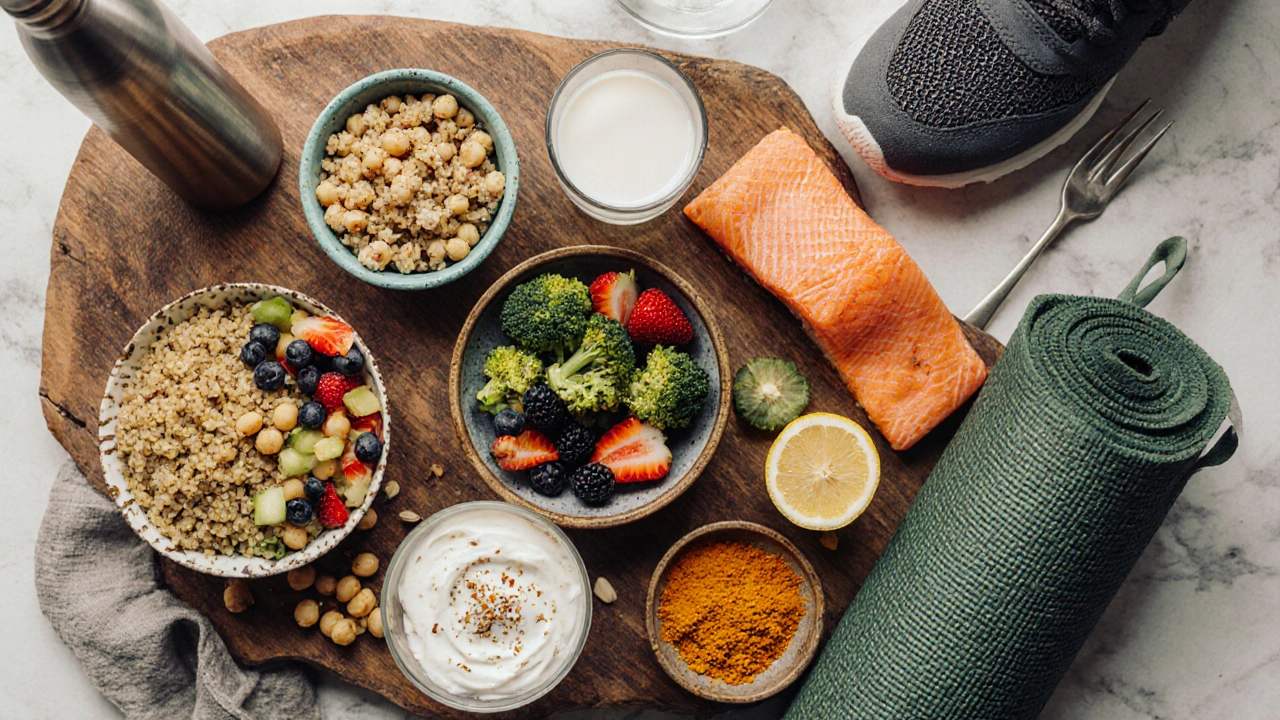Effective Diet and Lifestyle Changes to Manage Polyposis Symptoms
 Oct, 10 2025
Oct, 10 2025
Polyposis Diet & Lifestyle Checklist
Daily Fiber Goal
Target 25–30g of fiber per day to reduce polyp growth.
Track your daily fiber intake
Weekly Activity Tracker
Aim for 150 minutes of moderate activity weekly.
Checklist: Foods to Include
Checklist: Foods to Avoid
Sample Daily Meal Plan
Breakfast
Overnight oats with chia seeds, almond milk, blueberries, and cinnamon.
Lunch
Quinoa salad with chickpeas, kale, tomatoes, carrots, and turmeric-lemon dressing.
Dinner
Baked salmon with roasted broccoli and sweet potato wedges.
Living with Polyposis is a daily balancing act. The condition creates numerous colon polyps that can turn painful or become cancerous if ignored. While regular surveillance and medication are crucial, what you eat and how you move can dramatically ease symptoms, lower polyp growth, and improve overall wellbeing. Below you’ll find a step‑by‑step guide to the most practical polyposis diet tweaks and lifestyle habits you can start today.
What Polyposis Actually Is
Polyposis refers to a group of genetic disorders-most commonly familial adenomatous polyposis (FAP) and serrated polyposis syndrome-where hundreds to thousands of polyps line the colon and rectum. These growths are usually benign at first, but each carries a risk of turning malignant over time. Symptoms range from abdominal pain and anemia to rectal bleeding and altered bowel habits. Because the root cause is genetic, you can’t erase polyps with food alone, but you can influence the environment that feeds them.
Core Dietary Principles for Polyposis
The science behind diet and polyps points to three big ideas: increase protective nutrients, keep the gut moving smoothly, and limit substances that trigger inflammation. Below is a quick cheat‑sheet of the pillars you’ll build on.
- Fiber - Soluble and insoluble fiber bulk up stool and shorten contact time between carcinogens and the colon lining.
- Anti‑inflammatory foods - Turmeric, ginger, and berries lower chronic inflammation that fuels polyp growth.
- Calcium and Vitamin D - These minerals help cells differentiate normally, reducing the chance of abnormal growth.
- Omega‑3 fatty acids - EPA and DHA from fish or algae dampen inflammatory pathways.
Keeping these pillars in mind makes meal planning less overwhelming and more purposeful.
Foods to Embrace
Here’s a practical list of daily eats that hit the pillars hard.
- Whole grains (oats, quinoa, barley) - Provide 5‑7g of fiber per serving.
- Legumes - Lentils, chickpeas, and beans add protein and up to 10g of fiber per cup.
- Cruciferous vegetables - Broccoli, cauliflower, kale, and Brussels sprouts contain sulforaphane, a compound shown to trigger cancer‑preventing enzymes.
- Berries - Blueberries, strawberries, and blackberries are packed with antioxidants and soluble fiber.
- Fatty fish - Salmon, mackerel, and sardines supply 1‑2g of omega‑3 per 100g serving.
- Low‑fat dairy or fortified plant milks - Deliver calcium (≈300mg per cup) and often vitaminD.
- Turmeric‑spiced dishes - Curcumin, the active ingredient, has a documented anti‑polyp effect in animal studies.

Foods to Limit or Avoid
Just as important as what to add is what to keep out.
- Red and processed meats - High‑iron and nitrite content are linked to higher polyp numbers.
- Refined carbs and sugary drinks - Spike insulin and promote inflammation.
- Alcohol - Even moderate intake raises colon cancer risk.
- Very low‑fiber “low‑residue” diets - Should only be used short‑term before a colonoscopy, not as a lifelong plan.
Exercise and Everyday Movement
Exercise isn’t just for weight control; it improves gut motility and cuts systemic inflammation. Aim for at least 150minutes of moderate aerobic activity (brisk walking, cycling, swimming) each week. Add two sessions of strength training to keep muscle mass up, which helps insulin regulation-a hidden driver of polyp growth.
Stress, Sleep, and Their Hidden Power
Chronic stress spikes cortisol, which can weaken the gut barrier and promote inflammatory cytokines. Simple habits-5‑minute breathing drills, weekly yoga, or a short walk in nature-lower stress scores without major time investment. Sleep matters, too; 7‑9hours per night restores gut microbiome balance and supports DNA repair mechanisms that keep cells in check.
Sample One‑Day Meal Plan
Below is a concrete example that hits all the nutrients discussed. Feel free to swap proteins, grains, or fruits to match your preferences.
- Breakfast: Overnight oats made with rolled oats, chia seeds, almond milk (fortified with calcium & vitaminD), topped with blueberries and a dash of cinnamon.
- Mid‑morning snack: A small apple and a handful of walnuts (omega‑3 source).
- Lunch: Quinoa salad with chickpeas, chopped kale, cherry tomatoes, grated carrots, and a turmeric‑lemon vinaigrette.
- Afternoon snack: Low‑fat Greek yogurt (or soy yogurt) with a spoonful of ground flaxseed.
- Dinner: Baked salmon (150g) with a side of roasted broccoli and sweet potato wedges; drizzle with extra‑virgin olive oil.
- Evening: Herbal tea (ginger or peppermint) and a square of dark chocolate (≥70% cacao) for an antioxidant boost.
Practical Checklist & Pitfalls to Avoid
- Track daily fiber - Target 25‑30g; use a food diary or app.
- Take vitaminD supplement if blood levels <30ng/mL (common in the UK winter).
- Limit processed meat to <1serving per week.
- Schedule at least 30minutes of walking most days; set a phone reminder.
- Plan stress‑relief activities-write them in your calendar like any other appointment.
Common mistakes include swapping whole‑grain pasta for white pasta (fiber loss), using butter instead of olive oil (increases saturated fat), and skipping breakfast, which can lead to overeating later.
When to Talk to Your Doctor
Any sudden change in bowel habits, persistent abdominal pain, or unexplained weight loss deserves a prompt check‑up. Your gastroenterologist can guide you on colonoscopy frequency, discuss chemoprevention options (like low‑dose aspirin), and tailor nutritional advice to your genetic subtype. Keep a one‑page summary of your diet and exercise log for each appointment-that makes it easier for the doctor to spot trends.
| Aspect | High‑Fiber (Everyday) | Low‑Residue (Pre‑Procedure) |
|---|---|---|
| Primary Goal | Promote stool bulk, reduce transit time | Minimize fecal bulk for clear colon view |
| Typical Fiber Intake | 25‑30g/day | 5‑10g/day |
| Key Foods | Whole grains, legumes, fruits, veg | White rice, well‑cooked pasta, skinless chicken |
| Duration | Long‑term lifestyle | Usually 2‑3 days before colonoscopy |
| Effect on Polyps | May slow growth, improve gut health | Neutral - only a diagnostic aid |
Frequently Asked Questions
Can a high‑fiber diet shrink existing polyps?
Fiber alone doesn’t eradicate polyps, but studies show it can reduce the number of new polyps and slow growth of existing ones when combined with regular surveillance.
Is it safe to take aspirin for chemoprevention if I have polyposis?
Low‑dose aspirin has been shown to lower polyp counts in some patients, but it can increase bleeding risk. Always discuss dosage and contraindications with your gastroenterologist.
How much calcium should I aim for each day?
For adults with polyposis, 1,000mg of calcium per day (1,200mg if over 50) is recommended, preferably from dairy or fortified plant sources combined with vitaminD.
What are good low‑impact exercises if I have joint pain?
Swimming, water aerobics, and stationary cycling provide cardiovascular benefits without stressing the joints.
Should I avoid all dairy because of calcium concerns?
No. Low‑fat dairy is a top source of calcium and vitaminD. If you’re lactose intolerant, choose fortified soy or oat milk.
Bottom line: You can’t change the genes that cause polyposis, but you can shape the environment in which those genes act. By filling your plate with fiber‑rich, anti‑inflammatory foods, staying active, managing stress, and keeping an eye on calcium and vitaminD, you give your colon the best possible chance to stay healthy between medical checks.

Fredric Chia
October 10, 2025 AT 00:10The presented checklist aligns with current clinical guidelines; however, the fiber target appears optimistic for patients experiencing severe gastrointestinal symptoms.
Hope Reader
October 16, 2025 AT 15:03Wow, thanks for the ultra‑comprehensive list. Who knew eating kale could be a life‑changing event? 😏
Marry coral
October 23, 2025 AT 05:56Stop preaching and just give me a damn meal plan!
Emer Kirk
October 29, 2025 AT 19:48oh you sound so angry you probably forgot to eat your fiber today
emma but call me ulfi
November 5, 2025 AT 10:41Cool checklist, I’ll try to stick to the fiber goal but keep it low‑key so I don’t feel overwhelmed.
George Gritzalas
November 12, 2025 AT 01:33Really? You think "kale" is a miracle food? Let me correct you: "kale" is a leafy cruciferous vegetable, not a panacea. Also, your punctuation needs work-there’s a missing comma after "miracle". Anyway, keep it casual, but don’t sacrifice accuracy.
ruth purizaca
November 18, 2025 AT 16:26One must consider the gastronomic subtleties underlying these recommendations, lest we reduce nutrition to a mere checklist.
Shelley Beneteau
November 25, 2025 AT 07:18I appreciate the nuance, though I wonder about practicality for individuals juggling full‑time work and family commitments.
Sonya Postnikova
December 1, 2025 AT 22:11Great guide! 😊 It’s exactly what I needed to feel more in control of my polyposis.
Patricia Hicks
December 8, 2025 AT 13:04Honestly, this post feels like a breath of fresh air for anyone dealing with polyposis. The emphasis on soluble and insoluble fiber is spot‑on because we both know how crucial stool bulk is for reducing contact time with potential carcinogens.
Including turmeric and ginger isn’t just trendy; those compounds have been shown to modulate inflammatory pathways, which is a big deal for polyp formation.
Calcium and vitamin D aren’t just bone‑builders; they also encourage proper cell differentiation in the colon lining.
Omega‑3s from salmon or algae have anti‑inflammatory properties that complement the anti‑oxidants found in berries.
I love the sample meal plan because it’s realistic – you can swap quinoa for brown rice or lentils for black beans without losing the nutrient profile.
The snack ideas are practical and avoid the pitfall of “low‑residue” diets that are only meant for short‑term prep.
Exercise recommendations are solid: 150 minutes of moderate aerobic work plus two strength sessions align with the American Cancer Society guidelines.
Don’t forget that consistent sleep of 7‑9 hours supports gut microbiome health, which in turn can influence polyp development.
Stress reduction tips like breathing drills or short walks are low‑cost but high‑impact.
One thing to watch out for is the temptation to over‑track every gram of fiber; flexibility helps with adherence.
Also, while the post mentions “low‑fat dairy,” people who are lactose intolerant can opt for fortified plant milks rich in calcium and vitamin D.
Finally, remember that dietary changes complement, not replace, regular colonoscopic surveillance and any prescribed medication.
All in all, this checklist gives a balanced, evidence‑based roadmap that feels achievable rather than overwhelming.
Keep it up, and feel free to share your progress in the comments – community support can make a huge difference! 😊
ariel javier
December 15, 2025 AT 03:56The author’s reliance on anecdotal evidence and loosely cited studies is unacceptable; a rigorous, peer‑reviewed approach is required for medical guidance.
Bryan L
December 21, 2025 AT 18:49I get the frustration, but let’s keep the conversation respectful. 😊 We’re all here to help each other.